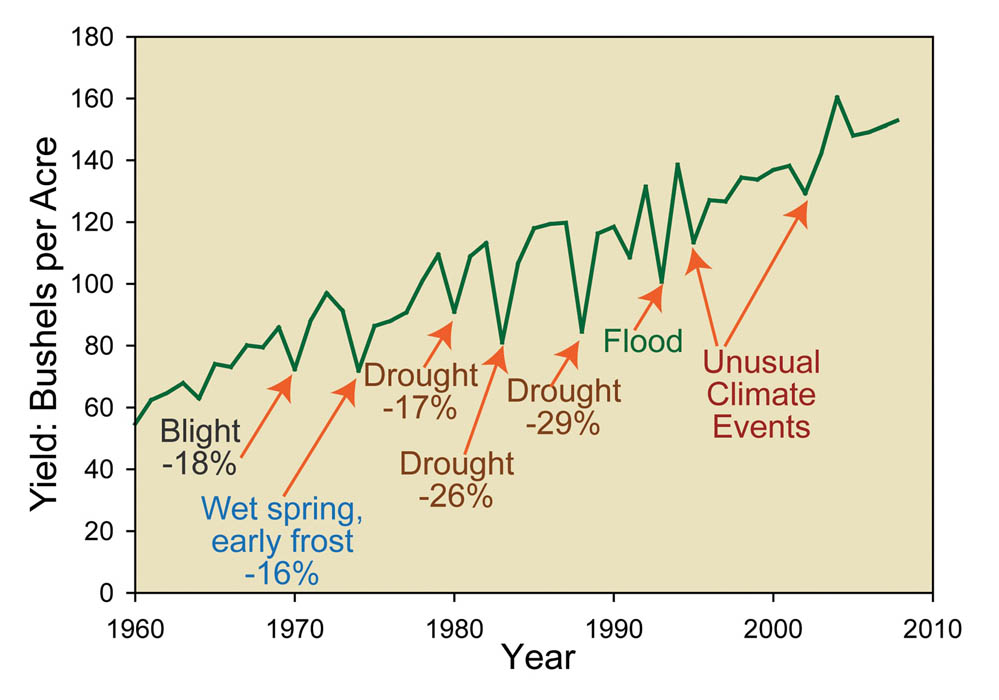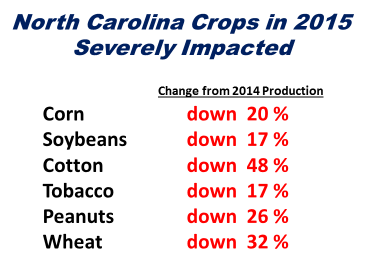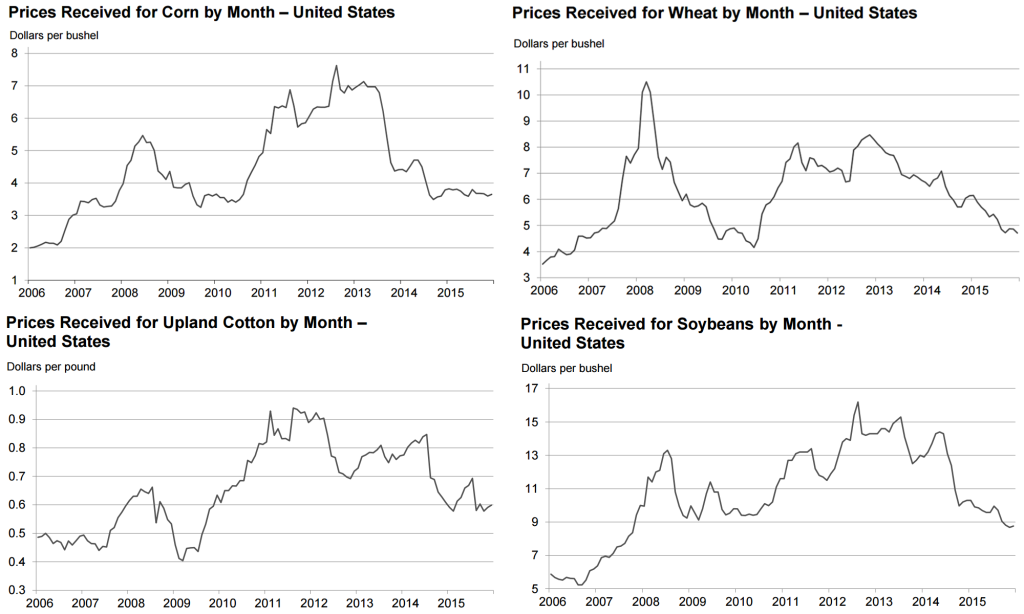Last week we told you about the difficult year North Carolina farmers had in 2015. This week we want to show you how that bad weather has converged with a few other factors to put many farmers in a really tight spot as they prepare for the 2016 growing season.

First of all, weather is always a wild card in agriculture. Here’s a chart (Figure 1) showing how weather events have affected US corn production over the last 50 years. Nearly every decrease in crop yields can be attributed to some adverse weather event. Farmers certainly understand this and do everything they can to manage risk, but there’s only so much they can do when extreme events occur.
(The other thing this chart demonstrates is how efficient farmers have become, more than doubling yields since 1960.)

While there are a number of factors that can contribute to fluctuations in production, weather is perhaps the most significant. Figure 2 provides some perspective on how North Carolina crop production was affected by adverse weather events in 2015. Yes, you are seeing that correctly – production was down significantly. So what does that mean? In the simplest of terms, farmers produced less and therefore had less to sell. Since North Carolina leans on agriculture as its number one economic driver, this obviously becomes problem #1.
The next problem facing farmers: prices. Farmers are “price takers” not “price makers” which means they don’t determine how much they get paid for what they produce, the market does. Low prices are definitely good for consumers and that can mean good things for farmers, too, when consumers are buying more farm products. But because farmers can’t adjust the price of their goods to reflect things like increased input costs or decreased supply, it’s possible that they can end up making very little or even losing money on their investment.
The next few charts do a great job of illustrating the recent downward trends in the prices farmers have been receiving for some of the crops grown here in North Carolina. So on top of having fewer ears of corn to sell, now farmers are getting paid less for what they’ve got. That’s problem #2.

The third problem farmers are facing is really the offspring of the first two problems, and that’s quality discounts. When farmers sell their crops, buyers will inspect the product to determine where it falls on a quality spectrum. The higher the quality, the better price the farmer receives. The flip-side of that coin is that a lesser-quality product will pay a lower price to the farmer. When weather conditions disturb when a crop is planted, how well it grows, and when it can be harvested, you end up with a less than ideal end product. In particular, cotton, tobacco, soybeans, and peanuts were subject to quality discounts in North Carolina. Considering prices are already low, farmers took an even deeper hit when they couldn’t deliver a high-quality product.
The final complication for farmers has to do with the timing of support payments under the Agriculture Act of 2014, commonly known as the Farm Bill. For simplicity’s sake, these support payments are part of a farmer’s safety net in times when prices and/or revenue fall below an established benchmark in a geographic area or for a specific commodity. Some commodities, like cotton, no longer have a price or revenue support mechanism in place. The problem is that, under the current legislation, farmers who are eligible to receive support payments from the US Department of Agriculture will not receive those payments until the fall of 2016. For farmers who have lost tens or hundreds of thousands of dollars, that can be a bitter reality.
All of this means that many farmers are finding themselves in a serious cash crunch. They invested in their operation in 2015. They bought seed, fertilizer, and equipment. They hired workers. They gave their time and energy to growing a successful crop. To manage risk, they bought insurance and invested in improved seed technologies that are more drought-resilient and produce higher yields; when it didn’t rain they used advanced irrigation systems. They did everything they could, but 2015 was a really rough year. Now 2016 expenses are coming due. On top of input costs and labor, they’ve got tax bills to pay. Some might need to make repairs or buy new equipment. It’s a stressful position to be in.
Agriculture is a major contributor to the economy in both the state and the nation, so it’s important that we help farmers bounce back. The Chairman of the US House Committee on Agriculture, Congressman Michael Conaway, said it best last week in his opening statements discussing the state of the rural economy, “. . . these conditions in farm and ranch country have ramifications not only for farm and ranch families but also for our rural communities and the national economy as a whole.”
Hopefully 2016 brings better weather and a better year for farmers. But in the meantime, North Carolina Farm Bureau will continue working to help North Carolina farmers, and to keep North Carolina agriculture strong.
